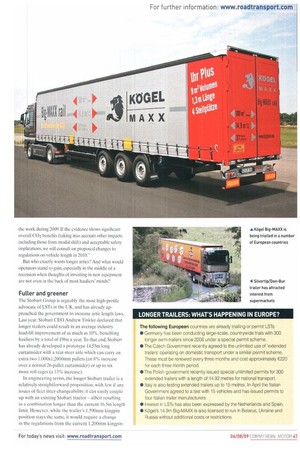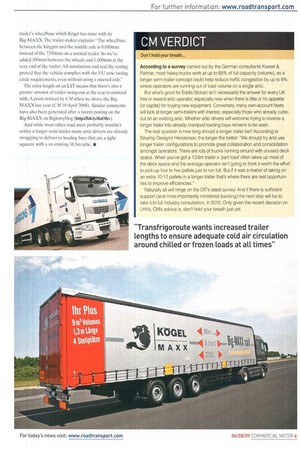Stretching the point
Page 46

Page 47

Page 48

Page 49

If you've noticed an error in this article please click here to report it so we can fix it.
Six months ago the DfT launched a study into longer semi-trailers. Is this just a sop to the industry after it cancelled trials into LHVs? And who wants longer semis anyway... especially in a recession?
Words: Brian Weathertey, additional report h„ Dominic Perry A little over a A little over a .... year ago, the transport secretary Ruth Kelly officially announced what the road transport industry had already long suspected. UK trials of Longer Heavier Vehicles (LHVs) were dead in the water.
Having cited a whole range of excuses, from fears over increases in emissions to worries over the inability of the infrastructure to cope with 'Super Lorries' (her words, not ours), she peremptorily dismissed all the lobbying from the Freight Transport Association (ETA) and Chartered Institute of Logistics and Transport as well as pro-LHV enthusiasts such as Dick Denby and Stan Robinson.
Was anyone really surprised? For many, the decision was another example of a transport secretary buckling under pressure from the rail lobby. Others simply saw it as the obvious response from a government desperate to avoid further bad publicity. "Negative and blinkered," was how the ETA described it. "Regrettable," said the Road Haulage Association (RHA). "A missed opportunity," was ('M's verdict.
New study commissioned Yet no sooner had Kelly kicked 60-bone, 25.25m LHVs into the long grass than it emerged, earlier this year, that the DfT was considering allowing artics with longer
semi-trailers — ironically one of the original vehicle combinations considered by the Transport Research Laboratory (TRL) in the department's own report. And in June, it duly commissioned a study into longer semi-trailers (LSTs).
So, is this latest move simply another sop to the 'Bigger is Better' brigade? Or is it a way of acceding to calls for greater vehicle efficiencies — without sending backbench MPs and the 'Great British Public' into a tail-spin?
Officially. the Dfl' says: "The study is focusing on the benefits and impacts of increasing the length of articulated HGVs by up to 2.05 metres, and will consider the overall CO2 impacts (including if used by a wide range of operators) and the potential safety impacts.
In terms of a timetable, it adds: "We expect to complete the work during 2009. If the evidence shows significant overall CO2 benefits (taking into account other impacts including those from modal shift) and acceptable safety implications, we will consult on proposed changes to regulations on vehicle length in 2010".
But who exactly wants longer artics? And what would operators stand to gain, especially in the middle of a recession when thoughts of investing in new equipment are not even in the back of most hauliers' minds?
Fuller and greener
The .Stobart Group is arguably the most high-profile advocate of LSTs in the UK, and has already approached the government to increase artic length laws. Last year, Stobart CEO Andrew Tinkter declared that longer trailers could result in an average industry load-fill improvement of as much as 10%, benefiting hauliers by a total of £9bn a year.To that end, Stobart has already developed a prototype 14.55m long curtainsider with a rear-steer axle which can carry an extra two 1,000x1,2000mm pallets (an 8% increase over a normal 26-pallet curtainsider) or up to six more roll cages (a 13% increase).
In engineering terms, the longer Stobart trailer is a relatively straightforward proposition, with few if any issues of fleet inter-changeability; it can easily couple up With an existing Stobart tractor — albeit resulting in a combination longer than the current 16.5m length limit. However, while the trailer's 1,590mm kingpin position stays the same, it would require a change in the regulations from the current 1,200mm kingpin to-rear-of-trailer length to accommodate a 12,9501nm measurement.
Supermarket giant Morrisons is also looking at LSTs and in particular the Silvertip Design/Don-Bur 16.0m trailer fitted with a command-steer rear bogie which can carry 32 pallets compared to a 13.6m trailer's 26.
Silvertip Design boss Carl Henderson also reports interest in it from the Post Office, However, he insists, "We're not going to create a lot of enthusiasm until we get a clear sign [from the DfT] that changes will happen in the length laws."
Meanwhile, on the Continent, German trailer-maker Kogel has been heavily promoting the use of longer semis through its 14.9m Big-MAXX concept. First unveiled in 2005, its additional 1.30m load platform can accommodate 37 euro-pallets instead of the normal 31 Unsurprisingly. Germany was the first country to dip its toe into the water with LSTs it's already three years into a comprehensive six-year trial, and when the original 300 permits were issued, they were quickly snapped up by 50 hauliers.
With its Big-MAXX, Ktigel has been instrumental in the further adoption of LSTs through trials in a number of other European countries and says that one in every eight artics could be taken off Europe's roads if longer semi-trailers were used more widely in other EU states.
Last hut not least, on a more modest note tempera ture-controlled trade association Transfrigoroute wants Brussels to increase trailer lengths to 13.8m to ensure adequate cold air circulation around chilled or frozen loads at all times, particularly when 33 euro-pallets are transported in a conventional 13.6m trailer (CM 9 October 2008). Graham Millard, fleet engineer at Transfrigoroute UK member Langdons, says: "Since we are a multi-ternperatue organisation, we support the call for a 200mm increase in trailer length to enhance air flow and improve product temperature control."
The downside
However, for every up there is a down. While longer semi-trailers could help reduce CO2 emissions the more freight (if not weight) you can get on a single artic the better however long your trailer it still has to meet the EU (and hence UK) artic turning circle regulations. These stipulate that a combination must be able to negotiate a turning corridor with an outer radius of 12.5m and an inner of 5.3m 'regular' 16.5m artic obviously meets this requirement.
For longer art ics to stay within that EU corridor there are a number of options from steering rear axles (as with the Stobart trailer) or, as in the case of the Silvertip/ Don-Bur trailer a fullysteerable bogie.
"We're well within the regulated Ell turning corridor with our trailer," confirms Silvertip's Henderson, "as we can operate within a very
narrow corridor with a 12.5m outer radius and a 7m inner well within the 12m 5.3m limit without any cut-in.
And that's measured to the side-guards not to wheels." Alternatively, you can adjust the trailer's wheelbase which Kbgel has done with its Big-MAXX. The trailer-maker explains: "The wheelbase between the kingpin and the middle axle is 8,000mm instead of the 7700mm on a normal trailer. So we've added 300mm between the wheels and 1,000rrim at the very end of the trailer. All simulations and real life testing proved that the vehicle complies with the EU artic tuning circle requirements, even without using a steered axle."
The extra length on an LST means that there's also a greater amount of trailer swing-out at the rear to contend with. A point noticed by CM when we drove the BigMAXX last year (CM 10 April 2008). Similar comments have also been generated after a recent posting on the Big-MAXX on Biglorryblog (http://bitIgduOtiv).
And while most other road users probably wouldn't notice a longer semi-trailer many arLic drivers are already struggling to deliver to loading bays that are a Light squeeze with a an existing 16.5rn artic. •




































































































































